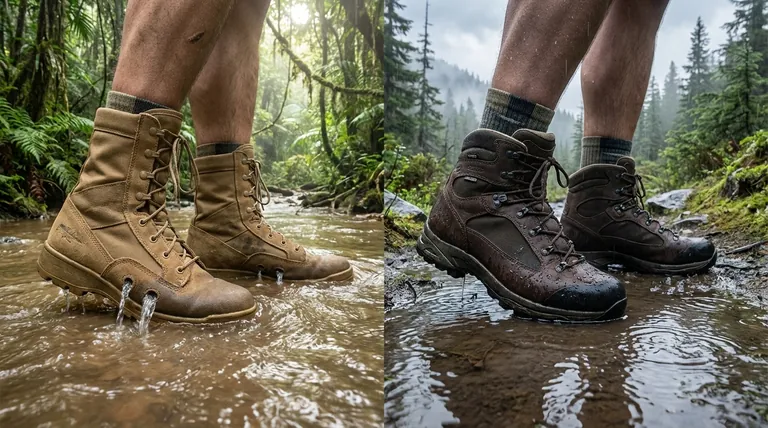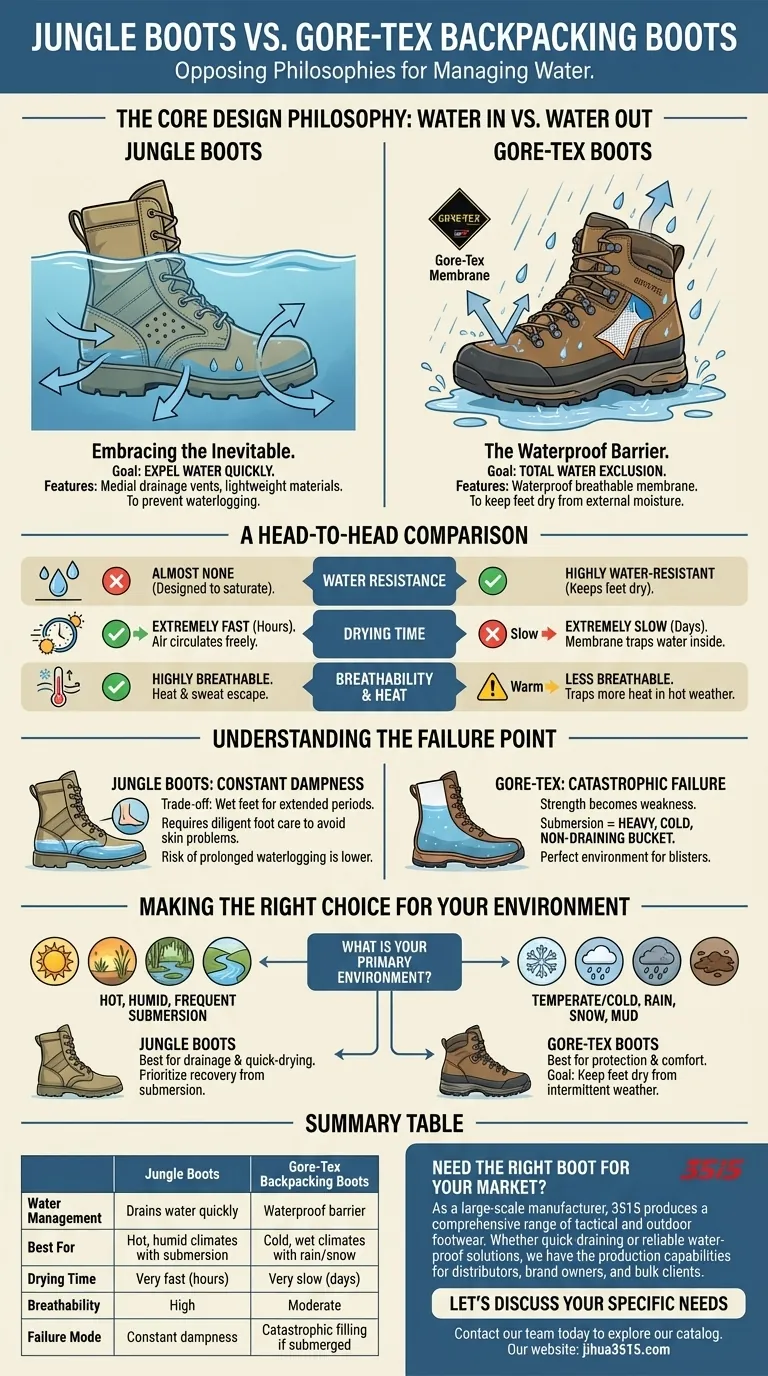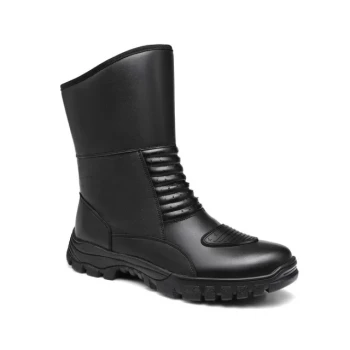The fundamental difference between jungle boots and Gore-Tex backpacking boots lies in their opposing philosophies for managing water. Jungle boots are designed to let water in and out, drying quickly, while Gore-Tex boots are designed to create a waterproof barrier, which takes an extremely long time to dry once that barrier is breached.
The core decision you are making is not about which boot is "better," but which water management strategy—rapid draining or total exclusion—is appropriate for the environment you will be in.

The Core Design Philosophy: Water In vs. Water Out
Understanding the intended purpose of each boot is critical to selecting the right tool for the job. Their designs are a direct response to two very different types of wet environments.
Jungle Boots: Embracing the Inevitable
Jungle boots were born from the realization that in tropical, swampy, or river-filled environments, your feet are going to get wet no matter what. The design accepts this as a fact.
Instead of trying to keep water out, their primary goal is to expel water as quickly as possible after being submerged. They achieve this with lightweight canvas or nylon uppers and, most critically, medial drainage vents (small holes on the instep) that allow water to pour out with every step.
The priority is to prevent prolonged waterlogging, which can lead to severe foot conditions like trench foot. They are built to be worn wet and to dry quickly in the sun or with airflow.
Gore-Tex Boots: The Waterproof Barrier
Gore-Tex backpacking boots operate on the principle of total water exclusion. They are built for environments where you will encounter rain, snow, puddles, or mud, but are unlikely to submerge your foot completely.
The key technology is the Gore-Tex membrane, a specialized layer with microscopic pores large enough to let water vapor (sweat) out but too small for liquid water droplets to get in.
This creates a "waterproof but breathable" environment inside the boot, designed to keep your socks and feet completely dry from external moisture.
A Head-to-Head Comparison
Each design philosophy creates distinct advantages and disadvantages depending on the situation.
Water Resistance
Jungle boots have almost no water resistance. They are designed to become saturated immediately upon contact with water.
Gore-Tex boots are highly water-resistant. They can keep your feet perfectly dry for hours while walking through rain, shallow streams, or wet grass, as long as water does not go over the top of the boot's cuff.
Drying Time
This is the most critical difference. Jungle boots dry extremely fast. Their minimalist construction and drainage vents allow air to circulate freely, often drying in just a few hours.
Gore-Tex boots dry extremely slowly. Once water gets inside—either by submersion or a leak—the waterproof membrane that was meant to keep water out now works against you, trapping it inside. A saturated Gore-Tex boot can take days to dry completely.
Breathability and Heat
Jungle boots are highly breathable. The canvas uppers and lack of a waterproof membrane allow heat and sweat to escape easily, making them ideal for hot and humid climates.
Gore-Tex boots are less breathable. While the membrane is designed to pass vapor, it is still a barrier that traps more heat than a simple fabric upper. In hot weather, this can lead to sweaty feet, even if no external water gets in.
Understanding the Trade-offs: The Failure Point
No boot is perfect for every condition. The choice comes down to understanding how each type fails.
The Catastrophic Failure of Gore-Tex
The strength of a Gore-Tex boot—its waterproof barrier—is also its greatest weakness. A single misstep into water that is deeper than the boot's cuff leads to catastrophic failure.
The boot instantly fills with water and becomes a heavy, cold, non-draining bucket on your foot. The trapped moisture and slow drying time create a perfect environment for blisters and other serious foot issues on a multi-day trip.
The Constant Dampness of Jungle Boots
The trade-off with jungle boots is accepting that your feet will be wet for extended periods. This requires diligent foot care.
You must pair them with quick-drying synthetic or wool socks (never cotton) and take every opportunity to remove your boots, dry your feet, and let the boots air out. Failure to do so can also lead to skin problems, though the risk of prolonged waterlogging is lower.
Making the Right Choice for Your Environment
Your decision should be based entirely on a realistic assessment of the conditions you will face.
- If your primary environment is hot, humid, and involves frequent river crossings or swamps: Jungle boots are unequivocally the correct choice for their drainage and quick-drying properties.
- If your primary environment is temperate or cold with rain, snow, and mud: Gore-Tex boots offer superior protection and comfort by keeping your feet warm and dry.
- If you prioritize the ability to recover quickly from a full submersion: Choose jungle boots.
- If your goal is to keep your feet dry from intermittent weather and full submersion is highly unlikely: Choose Gore-Tex boots.
Ultimately, matching the boot's design philosophy to your environment is the only way to ensure comfort and safety on the trail.
Summary Table:
| Feature | Jungle Boots | Gore-Tex Backpacking Boots |
|---|---|---|
| Water Management | Drains water quickly | Waterproof barrier |
| Best For | Hot, humid climates with submersion | Cold, wet climates with rain/snow |
| Drying Time | Very fast (hours) | Very slow (days) |
| Breathability | High | Moderate |
| Failure Mode | Constant dampness | Catastrophic filling if submerged |
Need the Right Boot for Your Market?
As a large-scale manufacturer, 3515 produces a comprehensive range of tactical and outdoor footwear for distributors, brand owners, and bulk clients. Whether your customers need quick-draining jungle boots for humid climates or reliable waterproof boots for colder trails, we have the production capabilities and expertise to deliver.
Let's discuss your specific needs: Contact our team today to explore our catalog and find the perfect footwear solution for your business.
Visual Guide

Related Products
- Wholesale Waterproof Tactical Boots Custom Suede & High-Traction Soles
- Factory Direct Wholesale Rain Boots Durable Waterproof & Fully Customizable
- High Performance Fire-Retardant Waterproof Safety Boots
- Premium Wholesale Waterproof Safety Boots High Performance Protection for Industrial Markets
- Wholesale Tactical Boots High-Traction & Reflective for Bulk & Brand Orders
People Also Ask
- How does breathability contribute to the comfort of tactical boots? Prevent Blisters and Boost Performance
- What are the advantages and disadvantages of waterproof tactical boots? A Guide to the Key Trade-Offs
- Are military camouflage boots waterproof? How to Choose Boots That Keep Feet Dry
- Why is waterproofing important for tactical boots? Protect Your Feet and Gear in Any Mission
- What waterproof technology is used in tactical boots? Unlock All-Weather Performance & Protection



















